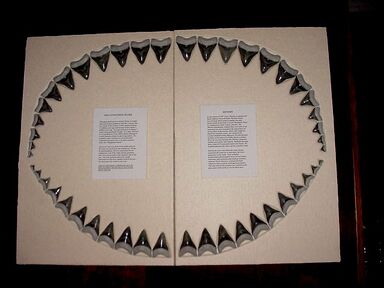
The most complete set of Carcharocles megalodon teeth every found. Bone Valley, FL. These are casts made from the originals. From the collection of Gordon Hubbell.
Carcharocles megalodon was a giant shark that lived during the Miocene - Pliocene epochs. The oldest remains of this species found are about 18 million years old and C. megalodon became extinct in the Pleistocene epoch probably about 1.5 million years ago. It was the apex predator of its time and is the largest carnivorous fish known to have existed, and quite possibly the largest shark ever to have lived. Scientists suggest that C. megalodon could grow to more than 15 metres (49 ft) long. This species is a member of the Lamnidae family but its classification is in dispute and a new genus has been proposed. Fossil evidence has revealed that C. megalodon fed upon large marine mammals.
Classification Dispute[]
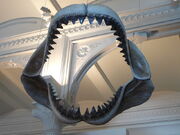
Jaw reconstruction at the AMNH, New York
- Main article: Carcharodon vs. Carcharocles
There is a major disagreement among scientists as to how C. megalodon should be classified. The controversy is that whether C. megalodon is a close relative of the extant great white shark or whether the two species are distant relatives. The trend among shark researchers is to dismiss the statement that C. megalodon is a close relative of the great white shark, in favor of citing convergent evolution as the reason for the dental similarity.
Megalodon within Carcharodon[]
The traditional view is that C. megalodon should be classified within the genus Carcharodon along with the great white shark. The Carcharodon proponents suggest that C. megalodon and C. carcharias share a common ancestor known as Palaeocarcharodon orientalis.
Megalodon within Carcharocles[]
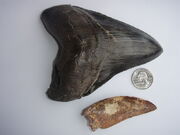
Carcharodontosaurus dinosaur tooth with Megalodon tooth.
Around 1923, the genus, Carcharocles, was proposed by two shark researchers, D. S. Jordan and H. Lecter, to classify a very similar shark C. auriculatus. Many marine biologists and paleontologists are now favoring the Carcharocles genus for C. megalodon.
One reason for this shift is that the teeth of C. megalodon are also similar to the teeth of some sharks that belong to Carcharocles lineage. The Carcharocles proponents suggest that the direct ancestor of the sharks belonging to the Carcharocles genus, is an ancient shark called Otodus obliquus, which lived during the Paleocene and Eocene epochs. According to Carcharocles proponents, Otodus obliquus evolved in to Carcharocles aksuaticus, which evolved in to Carcharocles auriculatus, which evolved into Carcharocles angustidens, which evolved into Carcharocles chubutensis, which eventually evolved into C. megalodon. Hence, the immediate ancestor of C. megalodon is C. chubutensis, because it serves as the missing link between Carcharocles angustidens and C. megalodon and it bridges the loss of the "lateral cusplets" that characterize C. megalodon.
Carcharocles proponents also point out that the great white shark is more closely related to an ancient shark Cosmopolitodus hastalis, the "broad tooth mako," than C. megalodon. This suggestion is given credence by many scientists due to some convincing evidence. One reason is that the teeth of I. hastalis and C. carcharias are remarkably similar in shape, differing only in that the former lack the characteristic serrations of the latter.
Fossils[]
| This section requires expansion.
|
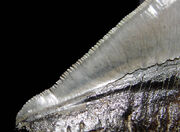
Close up of C. megalodon serrations
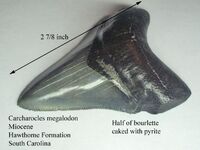
Pyrite covered Megalodon, Hawthorne Fomration, SC
C. megalodon is known primarily from fossil teeth and a few fossilized vertebral centra.
As with all other sharks, the megalodon skeleton was formed of cartilage and not bone, resulting in a poor skeletal fossil record. The teeth are in many ways similar to great white shark teeth but are much larger and can measure up to more than 18 cm in slant.
Teeth[]
Vertebrate[]
Discovery[]
Gallery[]
| Carcharocles |
|---|


